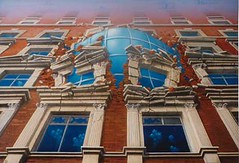 Despite the enormity of the problems facing us today, we at tomorrow today are not only optimistic about the fate of humanity, we're excited about the challenges we face.
Despite the enormity of the problems facing us today, we at tomorrow today are not only optimistic about the fate of humanity, we're excited about the challenges we face.
The key is to find an area that has an obvious and workable solution...
When we face problems in our lives, it often appears impossible and overwhelming because a real crisis involves many problems that tend to snowball; one disaster always leads to another. While it is true that the individual problems are connected, the solution always begins with looking at just one aspect of the crisis. Once a solution is found in one area, it becomes much easier to address the rest of the crisis. The key is to find an area that has an obvious and workable solution; ideally the solution will have a ripple effect or at least suggest solutions to the other problems we face. As above, so below--which is to say that the same methodology is needed when we collectively (and calmly) face the looming crises which threaten mankind's survival.
So, where to start? It is our contention that the first step is the one closest to home. In fact, it is our homes. The central problem facing us today is our relationship with the environment and this begins with the architecture of our dwelling-places. Simply put, architecture has the most profound, immediate, and far-reaching consequences of any area of human activity. We suffer from a strange and unprecedented dislocation from the natural world, and it is this dislocation that allows for the massive and terribly short-sighted environmental degradation which we have visited upon our beautiful, life-giving planet.
The most immediate impact of contemporary architecture is that it pollutes the environment. Consider this definition of sustainability in architecture from the Royal Institute of British Architects: "Sustainable design is a broad concept which aims to reduce the adverse effect of human activities on our world. Architecture is responsible for about 45% of the carbon dioxide (greenhouse gas) emissions in the UK. Architects are a large part of the problem, and consequently the solution-sustainable architecture." If the very buildings in which we live and work and go to school pollute the environment, it should be no real surprise to discover that our personal well-being is also directly, adversely affected by the abysmal current state of architecture. The fact is that we live in fuel-wasting, dehumanizing boxes, the architecture of which creates a cascading sequence of disastrous effects. The vast majority of humanity in the 21st century lives in squalid, sub-standard housing; you don't have to be a psychologist to imagine what this does to the human psyche.
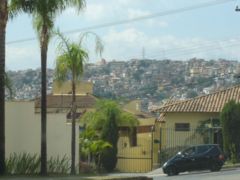 The stratification of society is in many ways reinforced by its housing patterns. For the very poorest among us, those who are either homeless or living in such terrible conditions that their physical and mental health is seriously impaired, the lack of access to decent housing constitutes a lack of freedom. The ramifications of the misery of the poor to the rest of us are as obvious as they are uncomfortable to consider. A gated community can't really keep out the resentment and despair engendered by the terrible housing situation of those less fortunate. The economic impact of poor housing is difficult to estimate: from the presence of lead, asbestos, and a whole host of other toxins to the simmering rage burning in the hearts of the dispossessed, the consequences are not contained within the blighted neighborhoods, and neither are the dangers. The new million-dollar houses we see behind those gates are poisoning their inhabitants just as surely, if somewhat more slowly.
The stratification of society is in many ways reinforced by its housing patterns. For the very poorest among us, those who are either homeless or living in such terrible conditions that their physical and mental health is seriously impaired, the lack of access to decent housing constitutes a lack of freedom. The ramifications of the misery of the poor to the rest of us are as obvious as they are uncomfortable to consider. A gated community can't really keep out the resentment and despair engendered by the terrible housing situation of those less fortunate. The economic impact of poor housing is difficult to estimate: from the presence of lead, asbestos, and a whole host of other toxins to the simmering rage burning in the hearts of the dispossessed, the consequences are not contained within the blighted neighborhoods, and neither are the dangers. The new million-dollar houses we see behind those gates are poisoning their inhabitants just as surely, if somewhat more slowly.
On a societal level, we are so cut off from the natural world that this distance allows us to ceaselessly, unthinkingly (and perhaps suicidally) poison the world. The natural world is resilient and has survived many catastrophic climatic events, from the aftermath of meteor strikes to extended periods of extreme cold, drought, and volcanic ash fallout, and yet, the biome--that thin sliver in the cross sectional view of Earth which supports all life--is a fragile miracle that is threatened on many fronts. The good news in all this is that the solution is in at our fingertips. There are alternatives that are not only better in every sense of the word, but they're actually cheaper!
We don't intend to weigh in on the supposed "controversy" over global climate change at this point because our focus is much closer than that looming crisis. Instead, we'd like to move from the notion of society's dislocation from the natural environment being responsible for our unconscionable acts of pollution to the impact of the architecture of our isolation on the individual, the basic "unit" of society. The effects of this impact are not solely psychological, since our health and general well-being are also directly, adversely affected, but the psychological effects are the mechanism which gives rise to so much other mayhem in the world.
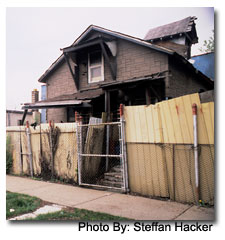
What Katrina Blew Away
Consider, briefly, the contrast between the housing crisis in New Orleans (pre- and post Katrina) and the much heralded Habitat for Humanity project. As most of the world knows, the damage from the hurricane was made much worse by the decrepit, dilapidated condition of the housing in New Orleans, especially in the poorest parishes. It is not generally recognized that the situation in New Orleans is not the exception, but rather the rule, not just in impovershed communities in the US, but around the world.
...the situation in New Orleans is not the exception, but rather the rule...
Most of the world's populations live in decaying, substandard housing which is quite vulnerable to the onslaught of nature, as well as exposure to the toxic consequences of our economic life. In the US, great inspiration and hope have been attached to the rebuilding of lives through the building of new and "better" houses by the charitable Habitat for Humanity. It may come as something of a surprise, therefore, to learn that these new and improved homes, while certainly an improvement, fall far short of what's needed for our continued survival as a species.
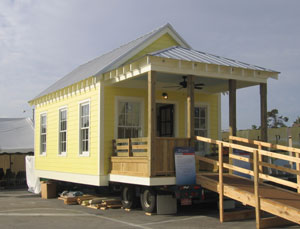
H. for H.'s "Katrina Cottage"
So what's the problem, you ask? Well, for starters, pretty as it might be, the "new" home is essentially no different from the old one, except that it's newer and slightly more energy efficient. This is not a great leap forward in design technology; Jimmy Carter's efforts will in no way decrease the impact of traditional housing on the environment, which is not to say that such improvements have not been made. The real tragedy of Katrina is that it was completely preventable--not the hurricane, but the damage it inflicted. Just like the environmental degradation caused by conventional architecture, the deaths and subsequent misery in New Orleans were completely avoidable. If this doesn't make you angry, it should at least make an advocate for change of you. As you will see, there exist many different types of houses that are not only impervious to storms and floods, but are also so efficient as to actually produce more energy and water than they consume! There are so many alternatives to the stifling boxes in which we "live" that it's very, very puzzling as to why the current paradigm perpetuates itself. It has been suggested to us that the wasteful, polluting disaster that is conventional architecture is maintained by the powerful as a means of controlling the masses, but we choose to believe that this situation is due primarily to a lack of information and public awareness. When we've finished
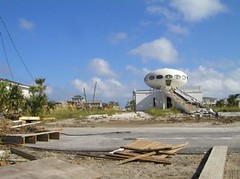
Even the "Space Ship" Dome Survives Hurricanes...
showcasing just a few of the brightest of alternatives, we're going to link the websites of sustainable builders here and ask that you do the same if you have a blog or website--this first step in staving off the coming doom is the most vital. If we don't address this situation first, the other steps will simply not be enough. We'd like to showcase a few more of these working alternatives to give you a sense of just how wide the variety of solutions is.

So,
What
Else
Is
There?

Malcolm Wells
Atrue father of the sustainable architecture movement is Malcolm Wells, whose work spans many decades and whose vision has inspired the new generation of green architects. 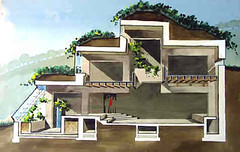
Southern Exposure of the Earth-Sheltered Wells Design
Many of the architects we're going to meet owe a great deal of their vision and their knowledge to the pioneering work of Malcolm Wells who gave them eyes with which to see and tools with which to work. But Mac, as he is known to those in his familiar, informal circle, didn't start out as the visionary of a new architecture; in fact, he was once a "proud" practitioner of the old. Until the inevitable moment of epiphany, that is, which he famously describes: "In 1964, after 10 years spent spreading corporate asphalt on America in the name of architecture, I woke up one day to the fact that the earth's surface was made for living plants, not industrial plants. I've been an underground architect ever since."
"...A building should consume its own waste, maintain itself, match nature's pace, provide wildlife habitat, moderate climate and weather and be beautiful. That's a series of pass/fail evaluation criteria..."
Wells' emphasis on earth-sheltered, solar-heated housing which makes mankind safe, secure, and in close harmony with the environment is an enormous legacy, a lasting gift to us all. Many people have wondered why it is that despite the decades of brilliant work that Mr. Well's has given us, there are still fewer than 5,000 earth-sheltered dwellings in the US--the answer to that question lies not in the vision of the designer, but in the difficulty in changing paradigms. We believe that Mac will yet live to see the first flowering of all that he has sown. Like many of the brightest stars in the sustainable universe, Malcolm Wells is a bit of a polymath, having "dabbled" in the following fields, according to the excellent website in his name:
Mac is an architect, writer, illustrator, draftsman, lecturer, cartoonist, columnist, and solar consultant. He has written for The Futurist magazine, High Country News, The Cape Cod Times ("Notes from the Underground" columnist), and other magazines. His foreword and intro appears in such books as The Natural House Book, Daylighting for Sustainable Design, and the The complete earth-sheltered house, and Rob Roy's The Complete Book of Underground Houses: How to Build a Low-Cost Home.
 One of the best known visionaries in this field is a man who's not really an architect at all; Roger Dean is an artist who is best known for his imaginative album-cover art in the '60s and '70s. Dean first became interested in sustainable, alternative housing as a result of listening to children talk about where their nightmares came from. It turned out to be largely related to physical "dead" spaces in their houses--under the bed, in dark and dusty corners, etc. From the architecture page of Dean's website we read that he has:
One of the best known visionaries in this field is a man who's not really an architect at all; Roger Dean is an artist who is best known for his imaginative album-cover art in the '60s and '70s. Dean first became interested in sustainable, alternative housing as a result of listening to children talk about where their nightmares came from. It turned out to be largely related to physical "dead" spaces in their houses--under the bed, in dark and dusty corners, etc. From the architecture page of Dean's website we read that he has:
"... designed a house for the new millennium: artistically beautiful, environmentally kind, but cheap and quick to build. It began as a college project to design a child's bed and grew into a radically new form of architecture for a world awakening to the damage done by post-war housing and office development."
And not just designed, but built as well:

Through the bedroom window at Roger Dean's Home for Life
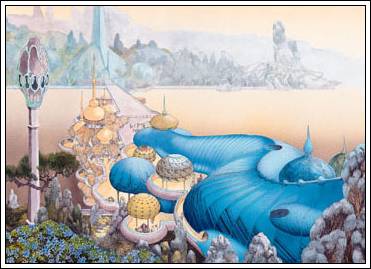
This is what Dean sees as the ultimate application of this type of design--villages and urban centers that reconnect us with the natural world while giving free rein to our imaginations.
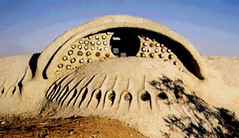 There are many different styles and types of sustainable architecture, from ancient designs like the bermed-wall Keldur houses you saw on this page's header, to futuristic designs and Bucky Fuller's geodesic domes. While these designs might vary greatly, they do share certain common features. ...stronger, safer, cleaner, healthier, cheaper...and they make you feel good, too...green roof & curvilinear design...They're stronger, safer, cleaner, healthier, cheaper and they make you feel good, too! Consider the fact that conventional housing acts as a water-proof barrier between the earth and the sky: the hydrologic cycle is broken everywhere we live, since water cannot be absorbed, circulate, percolate and evaporate. The more buildings go up, the less area the Earth has to breathe, drink and maintain its health. So let's look at some of the new wave in green building. But before we trip the light fantastic into what some people might regard as futuristic, impractical or outlandish, let's start by refreshing our collective memory. While much of what you're about to see is new, the concept is not. In terms of the environment, the best all-around design is green roof construction. In terms of the human psyche, curvilinear design appears to off the most comfort and security. So why not incorporate both? One of the very best sites for this winning combination is Earth Homes UK.
There are many different styles and types of sustainable architecture, from ancient designs like the bermed-wall Keldur houses you saw on this page's header, to futuristic designs and Bucky Fuller's geodesic domes. While these designs might vary greatly, they do share certain common features. ...stronger, safer, cleaner, healthier, cheaper...and they make you feel good, too...green roof & curvilinear design...They're stronger, safer, cleaner, healthier, cheaper and they make you feel good, too! Consider the fact that conventional housing acts as a water-proof barrier between the earth and the sky: the hydrologic cycle is broken everywhere we live, since water cannot be absorbed, circulate, percolate and evaporate. The more buildings go up, the less area the Earth has to breathe, drink and maintain its health. So let's look at some of the new wave in green building. But before we trip the light fantastic into what some people might regard as futuristic, impractical or outlandish, let's start by refreshing our collective memory. While much of what you're about to see is new, the concept is not. In terms of the environment, the best all-around design is green roof construction. In terms of the human psyche, curvilinear design appears to off the most comfort and security. So why not incorporate both? One of the very best sites for this winning combination is Earth Homes UK.
"The straight line is something cowardly, drawn with a rule,
without thought or feeling; it is a line
which does not exist
in nature."
"The
straight line
is the only sterile line,
the only line which does not intuit man as the image of God."
(Friedensreich Hundertwasser)
 Meet Peter Vetsch, Swiss master of curvilinear architecture, resident genius at Earth Homes UK. Vetsch has been building (and living in) curvilinear dwellings for many decades. His work is the result of a vision he shares with many of us as to the precarious situation in which we find ourselves. we need to respond to the changing climate conditions by adapting sustainability as the guiding principle ...Having been so recklessly attacked by the consequences of our economic life, as well as by our short-sighted, blighted architecture, the earth is fighting back. At the Earth Homes UK website, the environmental crisis we face is seen as a "battle" which has an uncertain end. In order to respond to the onslaught of nature ("...increasingly destructive storms and droughts...ice shelves melting at an alarming rate and behind them glaciers moving towards the sea much faster, with consequences that are likely to affect all life on the planet"), Vetsch and Earth Homes believe that we need to respond to the changing climate conditions by adapting sustainability as the guiding principle in all that we do:
Meet Peter Vetsch, Swiss master of curvilinear architecture, resident genius at Earth Homes UK. Vetsch has been building (and living in) curvilinear dwellings for many decades. His work is the result of a vision he shares with many of us as to the precarious situation in which we find ourselves. we need to respond to the changing climate conditions by adapting sustainability as the guiding principle ...Having been so recklessly attacked by the consequences of our economic life, as well as by our short-sighted, blighted architecture, the earth is fighting back. At the Earth Homes UK website, the environmental crisis we face is seen as a "battle" which has an uncertain end. In order to respond to the onslaught of nature ("...increasingly destructive storms and droughts...ice shelves melting at an alarming rate and behind them glaciers moving towards the sea much faster, with consequences that are likely to affect all life on the planet"), Vetsch and Earth Homes believe that we need to respond to the changing climate conditions by adapting sustainability as the guiding principle in all that we do:
"More sustainable homes are one of the fundamental ways of doing this. We need low energy, low impact homes and in many regions we need homes that protect rather than kill and injure. The high numbers of people killed in what we call natural disasters are rarely killed or injured by the wind, water, wave or quake - they are killed by their own homes or debris from someone else's.
We need to build safer, more sustainable homes that work as an effective shelter against a harsher more unpredictable climate. The Earth Homes design and construction method is the first of what is sure to be many new crucial developments in this area.
These homes will not fall apart like traditional rectilinear architecture.
Their curvilinear shape does not confront wind and wave with a perpendicular wall to be blown down or pushed over. Neither will they break apart by shaking of the foundations as rectilinear buildings do.
With a shape that sheds the elements efficiently,high thermal mass, geothermal heat exchange, smart home technology, the use of less or non toxic building materials, more practical use of the site, low impact design, extended service life and greater self sufficiency. These are are some of the sustainable features intrinsic to the Earth Home concept. Building for the future."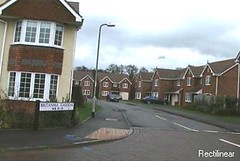
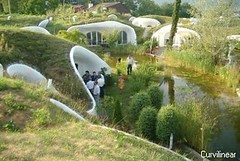
Today and tomorrow, in the world according to Peter Vetsch.
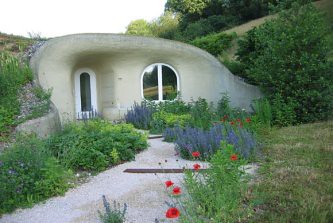
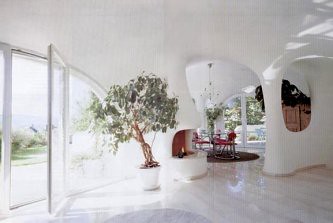
"Low impact earth sheltered housing is now an affordable and sustainable solution for building unobtrusive homes in the natural environment. These durable environmentally advanced smart homes are also ideal for agricultural diversification projects, for small clusters of holiday lets and golf lodges. This earth sheltered style can also be designed to serve as offices and small rural business units that are economical to run and easy to maintain."
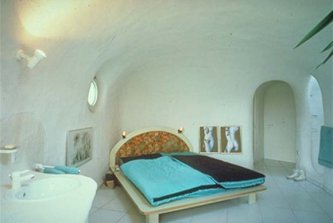
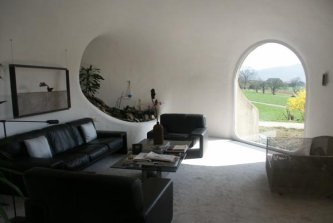
"More homes are desperately needed in rural areas and here is one solution that could slow down, perhaps even halt the destruction of our countryside by the ever increasing spread of urban sprawl. There is now an alternative to the box and a much more subtle way of living in the green environment."
There's an entire industry that has grown in response to the demand for alternatives to the box housing that contributes to the ongoing environmental degradation of the planet and the isolation and stratification of human society. A very unusual company called Biotecture travels around the world building truly sustainable homes (completely off the grid--no electricity, water, or sewage infrastructure needed, built from recycled and indigenous materials) and training teams of builders to build homes and train more builders. The short earthship movie (11 min.) is a fascinating statement in its own right. On that note, we'll close for today with another great short film, the Ecovillage Tour, which features a working sustainable community called The Farm:
'Til next time...
Living Systems Sustainable Architecture

One of the messages of eco-feminism is that we all must cultivate the human characteristics of gentleness and caring, which would mean giving up the hierarchical patriarchy and all its deadly privileges. Susan Griffin (Woman and Nature) and Petra Kelly, founder of the Green party, also understood this synthesis of ecology and feminism. Here is what Susan Griffin says: “Long ago we gave up ourselves.. .we have traded our real existence, our real feelings for a delusion. Instead of fighting for our lives, we bend all our efforts to defend delusion. We deny all evidence at hand that the civilization which has shaped our minds, is also destroying the earth.”
For western civilization, the world consists of a pyramid, with God and angels on the top, and earth and everything in it, underneath. And on the earth, nature is at the bottom, while white human males are at the top of this hierarchy. And the most privileged occupation is the objective, scientific investigation and manipulation of nature—bereft of emotions. Religion and science have combined to deepen our alienation from this earth. “If the church once offered the denigration of incarnate life as a solution to the human condition, now science offers us the Control of Matter as our rescue.” (Susan Griffin, Eco-Feminism).
The thought process that allows us to believe that we are above the earth is our intellectual response to our deep- seated fear of being overcome by nature. We have learned to think that we must take control of our environ- ment in order to survive. As early as the 14th Century, witch burning bears evidence of man’s fears, which was utilizing the (then) recent scientific discovery about the cosmic oriler as a justification. In the 16th Century, the slave trade is a demonstration of the white man’s condescension, viewing the black people of Africa as primitive and inferior, and manifested by their close connection to nature.
We have denied our essence and forgotten who we are. Unfortunately, we are still engaged in breaking the heart and spirit of nature, which is actually our very own heart and spirit. I sincerely believe that in our own secret knowledge, and our collective unconscious mind, we remember that nature is an essential part of us, our society, and our culture. Our memory of this natural attachment to life still exists. Maybe even our own breath reminds us of a time when we were curious - and when nature felt like an integral part of who we are.
Our insecurity does not need to be encouraged as it creates the need to control our surroundings instead of cohabitate with it. We so dearly need peace for people, animals and this earth, that we must become active participants in saving our Earth, thus saving ourselves.
Reminds me of Lord of the Rings. I would appreciate a more complete picture of the architecture to include the self sufficiency elements of gardens. root cellars, animal husbandry etc. Overall impression is positive but highways and byways, cul de sacs all have to go.
It's no wonder to me that the planet is facing extinction. The infrastructure is simply not sustainable nor is it pleasing. My suggestion would be that we should compost. This is the first step in saving the planet.
Billions of little three pound muscles scale the earth, skittering along the color spectrum of light with swords raised to Time.
Amen, and amen to that. Weirdly, the small minority of three-pounders who raise the blades of their minds to time, instead of the vorpal swords favored by the murderous beasties, sometimes find a rare cosmic radiation which causes the intrepid 3L Bees to mutate into loving warriors on the edge of time who then grieve properly for their ignorant, senselessly dying brethren. It is hoped that the process of grieving might liberate some of the innocent gray creatures from their prisons of bone and time. Much goodwill flows through and to them.
And this is how something can come from nothing: the grand miracle of fecundum ex nihilo, or the ever-complexifying spiral, in the popular mythology.
Many thanks for that ideogrammic monologue. Is there a soundtrack to it?
Dan..Sounds like survival into the 21st century. Check out zeolite and see if there is a local source for your efforts..
The thought process that allows us to believe that we are above the earth is our intellectual response to our deep- seated fear of being overcome by nature. We have learned to think that we must take control of our environ- ment in order to survive. As early as the 14th Century, witch burning bears evidence of man’s fears, which was utilizing the (then) recent scientific discovery about the cosmic oriler as a justification. In the 16th Century, the slave trade is a demonstration of the white man’s condescension, viewing the black people of Africa as primitive and inferior, and manifested by their close connection to nature.